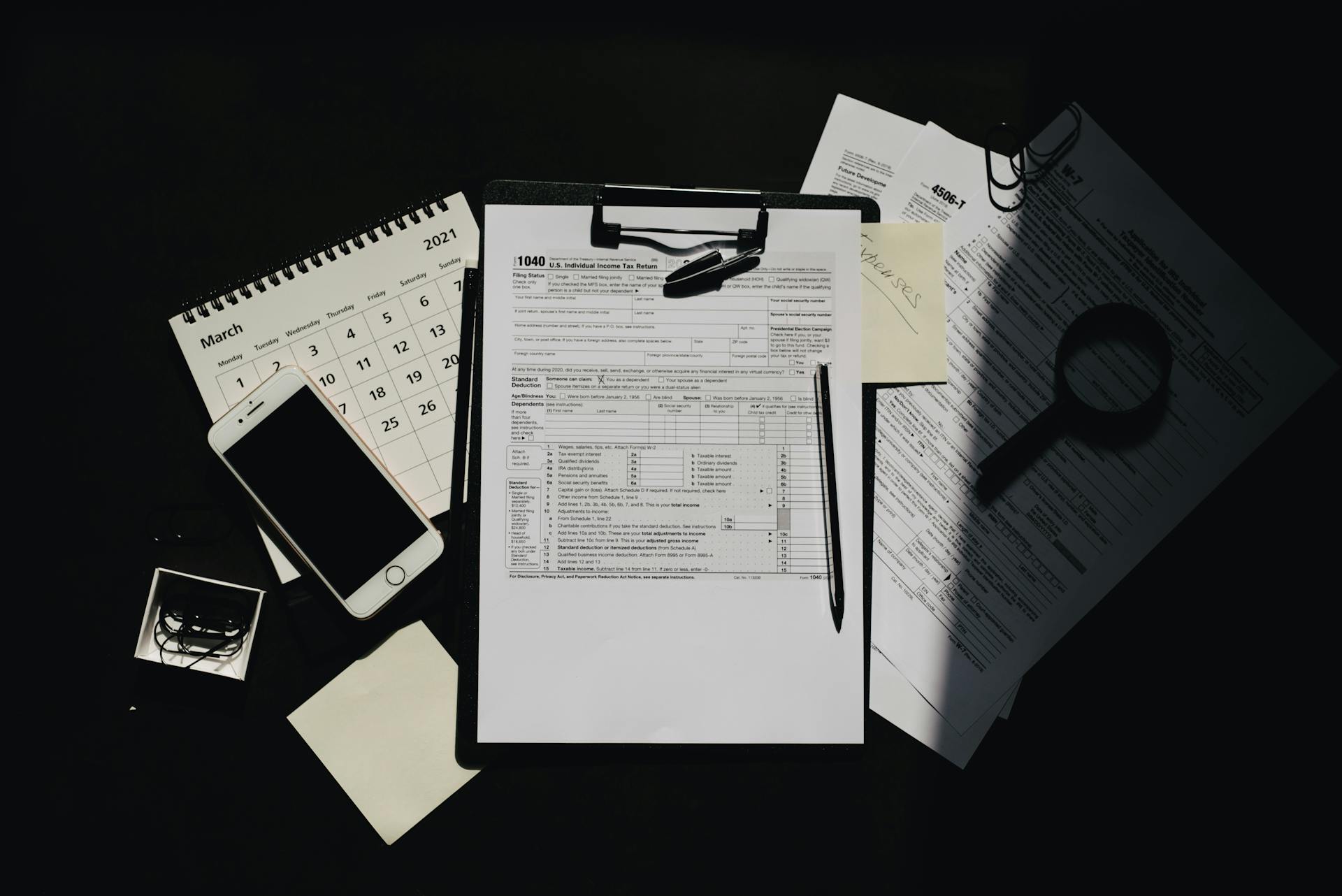
A forensic audit is a thorough examination of a company's financial records to identify any discrepancies or irregularities. This process can be triggered by a whistleblower, an internal investigation, or even a government agency.
The purpose of a forensic audit is to uncover the truth about a company's financial dealings, often in response to allegations of fraud or embezzlement. It's a way to hold individuals accountable for their actions and prevent future financial mismanagement.
A forensic audit typically involves a team of experts, including accountants, lawyers, and investigators, who work together to gather and analyze evidence. They may review financial statements, interview employees, and examine company policies and procedures.
The goal of a forensic audit is to provide a clear and objective picture of a company's financial situation, which can be used to make informed decisions about the future of the organization.
What Is a Forensic Audit?
A forensic audit is an examination of financial records to find any illegal financial activity. It's a process that involves investigating potential crimes or assisting with legal cases.
Forensic audits are conducted by Certified Fraud Examiners (CFEs) or forensic accountants, who have the necessary expertise to examine financial records and identify any suspicious activities.
These experts use various tools and techniques, such as checklists and forensic audit mortgage software, to help them in their investigation.
The goal of a forensic audit is to gather evidence that can be used in a court of law or legal proceeding. The results of a forensic audit are prepared with the understanding that they may be presented in court.
A forensic audit can be triggered by various factors, including suspicions of fraud or theft, unexpected differences in account balances, and unexplained differences in reconciliation procedures.
Here are some common reasons why a forensic audit may be necessary:
- Suspicions of fraud or theft arise
- Account balances are unexpectedly different from projections
- Reconciliation procedures result in unexplained differences
- Theft of personally identifiable information has occurred or business systems have been hacked
- A whistleblower has reported potential financial misconduct
In some cases, a forensic audit may also involve disputes related to bankruptcy filings, business closures, and divorces.
Why Is Conducted?
A forensic audit is conducted to uncover the truth behind financial discrepancies and irregularities.
Forensic audits are made for several reasons, including the following: to investigate financial mismanagement, identify theft, or embezzlement.
Financial mismanagement can be a complex issue, but forensic audits help to pinpoint the problem and take corrective action.
Forensic audit investigations are also made to identify internal control weaknesses, which can be a major reason for financial discrepancies.
In some cases, forensic audits are conducted to determine if a company's financial statements are accurate and comply with regulatory requirements.
Worth a look: Iesba Group Audits
Planning and Investigation
Planning a forensic audit involves understanding the scope of the investigation. A forensic auditor will plan their investigation to achieve specific objectives, including identifying what fraud is being carried out and determining the period during which the fraud occurred.
The auditor will also plan to discover how the fraud was concealed, name the perpetrators of the fraud, and quantify the loss suffered as a result of the fraud. Gathering relevant evidence that is admissible in court is also a key objective.
A thorough forensic audit includes a holistic review of financial data and non-financial information. This is a critical step in identifying and evaluating alleged fraud and corruption.
The auditor will identify the focus of the audit, such as possible fraud in terms of the quality of raw materials supplied. The forensic auditor will then plan their investigation to achieve objectives such as identifying what fraud is being carried out and determining the time period during which the fraud has occurred.
A forensic auditor is required to have special training in forensic audit techniques and in the legalities of accounting issues. They will perform additional steps beyond regular audit procedures to achieve their objectives.
Here are the key objectives of a forensic audit investigation:
- Identify what fraud, if any, is being carried out
- Determine the time period during which the fraud has occurred
- Discover how the fraud was concealed
- Identify the perpetrators of the fraud
- Quantify the loss suffered due to the fraud
- Gather relevant evidence that is admissible in the court
- Suggest measures that can prevent such frauds in the company in future
Collecting and Reporting Evidence
Collecting and reporting evidence is a crucial part of a forensic audit. A forensic auditor must collect adequate evidence to prove the fraudster's identity, reveal the details of the fraud scheme, and document the financial loss suffered and the parties affected by the fraud.
The evidence collected should be presented in a logical flow to help the court understand the fraud and the evidence presented. Forensic auditors must take precautions to ensure that documents and other evidence collected are not damaged or altered by anyone.
A forensic audit requires a written report about the fraud to be presented to the client. The report should include the findings of the investigation, a summary of the evidence collected, an explanation of how the fraud was perpetrated, and suggestions for preventing similar frauds in the future.
Common techniques used for collecting evidence in a forensic audit include substantive techniques, such as reconciliations and document reviews, analytical procedures, computer-assisted audit techniques, and understanding internal controls and testing them.
A forensic auditor should include the following in their report:
- The findings of the investigation
- A summary of the evidence collected
- An explanation of how the fraud was perpetrated
- Suggestions for preventing similar frauds in the future
During court proceedings, the forensic auditor should be present to explain the evidence collected and how the suspect was identified. They should simplify complex accounting issues and explain them in layman's language.
Types of Forensic Audits
Forensic audits can be conducted for various purposes, including fraud, corruption, and money laundering. Kroll's teams of experts provide a comprehensive analysis that includes identifying illicit fund flows, scrutinizing procurement contracts and loan agreements, and uncovering patterns in complex datasets.
A thorough forensic audit is a critical step in identifying and evaluating alleged fraud and corruption, and the results must meet the highest litigation standards for potential use in legal action. This involves a holistic review of financial data and non-financial information.
Some common types of forensic audits include:
- Fraud, Corruption and Money Laundering
- Intelligence, Transactions and Due Diligence
- Reputational Risk
- Regulatory and Compliance Risk
- Litigation and Disputes
- Information and IP Risk
Case Study in Mongolia
In Mongolia, a forensic audit was conducted as part of the Extended Fund Facility program with the International Monetary Fund. The Bank of Mongolia identified six banks in need of additional capitalization and retained Kroll to verify the source of the funds used to address the capital shortfalls.
Kroll's forensic audit included detailed financial fund flow tracing and analysis of related parties. We identified several transactions requiring clarification and warranting closer review by the Bank of Mongolia.
Explore further: Forensic Accountant Find Hidden Bank Accounts
The audit involved reviewing the financial records of the banks, including their capital and loan draws. We also conducted a site inspection and reviewed independent valuation reports to support the construction costs.
Kroll's investigation found no evidence that the funds provided by the syndicate of lenders were used in the payment of bribes or other irregularities. However, we did identify irregularities in the awarding of the concession.
In this case, the forensic audit helped the Bank of Mongolia to identify potential issues and take steps to improve the financial health of the banks under its supervision.
Money Laundering Investigations
Money laundering investigations are a critical aspect of forensic audits, helping clients unravel complex money-laundering operations and track illicit fund flows around the world. Kroll's teams of experts, including forensic accountants and investigators, work tirelessly to identify patterns in complex datasets and uncover evidence of money laundering.
Fraud, corruption, and money laundering are often interconnected, making it essential to conduct a thorough forensic audit to identify and evaluate alleged wrongdoing. Kroll's global network of business intelligence professionals provides our audits with the local political, economic, and industry insight needed for clarity in emerging and frontier markets.
A forensic audit typically involves a holistic review of financial data and non-financial information to identify illicit fund flows, scrutinize procurement contracts and loan agreements, and investigate counterparties. This comprehensive analysis is critical in gathering evidence that forms the basis of fact-finding reports to meet the highest evidentiary standards.
Key areas of focus in money laundering investigations include:
- Identifying illicit fund flows
- Scrutinizing procurement contracts and loan agreements
- Investigating counterparties
- Uncovering patterns in complex datasets
By conducting thorough money laundering investigations, Kroll helps clients understand the scope of the issue and develop strategies to prevent future occurrences. Our teams work closely with clients to provide recommendations for further investigations, enhancements to internal controls, and governance structures to mitigate the risk of money laundering.
Frequently Asked Questions
Can a CPA perform a forensic audit?
Yes, a CPA can perform a forensic audit, but they must also obtain specialized certification in financial forensics through the American Institute for CPAs (AICPA). This certification requires additional education, training, and exams beyond the CPA certification.
Who pays for a forensic audit?
The party hiring a forensic accountant is responsible for paying for their services. This party typically lists the accountant as an expert witness in court proceedings.
How long does a forensic audit take?
A forensic audit typically takes around 50-70 hours, but can take longer if multiple years are involved, adding an additional 30-40 hours per year. The exact duration may vary depending on the complexity of the investigation.
How much does a forensic audit cost?
A forensic audit can cost between $5,000 and $10,000, making it a significant financial investment for small businesses. This cost can be a substantial burden, but understanding the benefits of a forensic audit can help businesses decide if it's worth the investment.
What is financial crime audit?
Financial crime audit refers to the process of reviewing and examining an organization's financial systems and activities to identify and prevent potential financial crimes, such as money laundering and embezzlement. This proactive approach helps organizations detect and mitigate financial risks, ensuring compliance with regulations and protecting their assets
Sources
- https://www.eidebailly.com/insights/articles/2019/3/forensic-audit-vs-internal-audit
- https://strategiccfo.com/articles/audit/forensic-audit/
- https://www.investopedia.com/terms/f/forensic-audit.asp
- https://www.kroll.com/en/services/forensic-investigations-and-intelligence/fraud-corruption-and-money-laundering/forensic-audits
- https://corporatefinanceinstitute.com/resources/accounting/what-is-a-forensic-audit/
Featured Images: pexels.com


